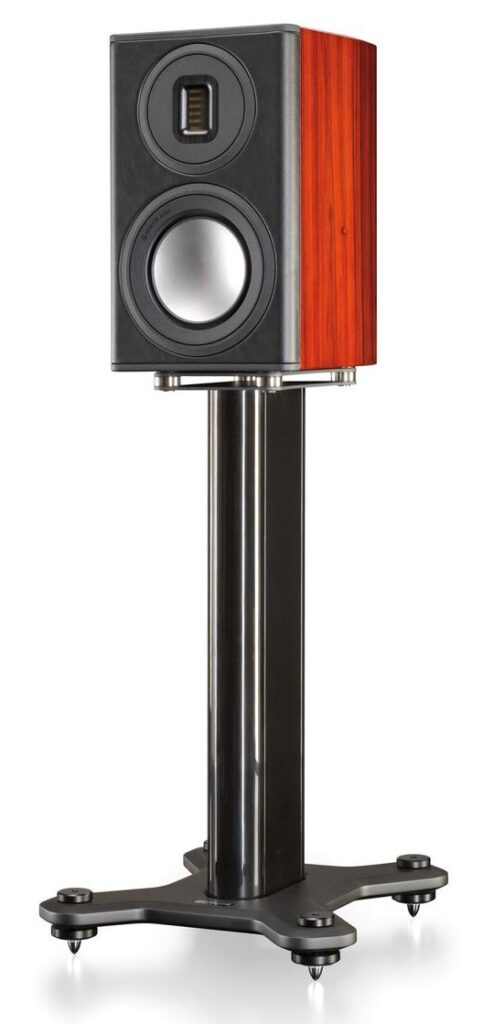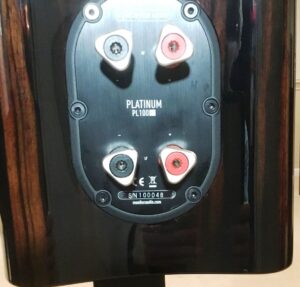The Monitor Audio PL100 II is the smallest member of Monitor Audio’s top-level Platinum series. The PL100 was introduced in 2008 and the upgraded PL100 II model hit showrooms worldwide in 2016. The II version includes a single 6.5″ RDT II mid-bass driver and MPD tweeter. “RDT II” is Monitor Audio’s second-generation midrange-woofer sporting a smooth concave cone. The ported Platinum PL100 II have beautiful, furniture-grade cabinets and have a list price of $5,795.00 per pair which includes a 5-year warranty. Matching 24” stands are $600 for a pair.
From the Monitor Audio Web site:
(The RDT II woofer-midrange has a) “composite ‘sandwich’ structure made from ultra-thin low mass skins, bonded to a honeycomb Nomex® core material. It is very light and very strong. RDT II uses C-CAM for the front skin, while the rear skin is made from a woven carbon fibre material. (This) structure reduces distortion by over 8 dB above 300 Hz, which makes RDT II the lowest distortion cone technology in Monitor Audio’s history.”

The MPD (Micro Pleated Diaphragm) tweeter “represents an imaginative re-working of an existing technology. Using a new, proprietary low-mass pleated diaphragm with a surface area eight times larger than that of a traditional dome tweeter, the MPD transducer works like a super-fast accordion by rapidly squeezing the pleats to produce a smooth, wide, naturally fast response up to 100 kHz”. This is similar to the Heil Air Motion technology, also used by other manufacturers, and was originally introduced 30 years ago and updated in the latest Monitor Audio speakers with modern engineering.
Other components on hand during the audition include a VPI Aries 3 turntable with a Kuzma 4-Point tonearm, ZYX UNIverse Premium and Miyajima Madake moving coil cartridges; B.M.C. MCCI ULN and Pass Labs XP-25 phono preamplifiers; custom Windows 10 music computer running JRiver Media Center; Wyred 4 Sound DAC 2v2SE 10th Anniversary DA converter; RME ADI-2 Pro AD/DA converter with external power supply; Pass Labs XP-22 and Wyred 4 Sound STP-SE Stage 2 preamplifiers; Wyred 4 Sound ST-750 LE, Valvet E2, Primaluna Prologue 5 and Pass Labs XA30.8 power amplifiers; Focal Sopra 1 loudspeakers with the lowest few Hertz supplied by a pair of JL Audio e110 subwoofers, Revel PerformaBE M126Be, Xavian Perla Esclusiva, and Focal Chorus 714 loudspeakers borrowed from the HT system. The audio cabling is Audioquest WEL Signature and Mogami interconnects and speaker cables. USB cables are Straight Wire USB-F. Power cords include my DIY power cord and Straight Wire Pro Thunder. Power protection and purification are provided by a PS Audio Dectet for the preamplifiers and source components, and a PS Audio Quintet for the power amplifiers. The Quintet includes a standard 1/8″ trigger for remote turn-on and -off of power amplifiers that lack a 12V remote trigger.
The sensitivity – or efficiency, if you prefer that term – is rated at 88 dB. However, the Monitor Audio, “MA”, speakers are apparently less sensitive than the 86 dB Revel M126Be. The volume control needed a higher setting for the same volume. The MA speakers are much less sensitive than the 90 dB Focal Sopra 1. Where the 12 Watt Valvet E2 amp has enough gain for the Focals in my room, and just barely enough for the Revels, the MA speakers really need more power. An amplifier able to provide 60-120 Watts is recommended by Monitor Audio.
The bass reaches down to the upper 30 Hz range in my room, although bass definition and resolution decreases below about 80 Hz. A solid-state amplifier is recommended to maximize bass quality. The two JL Audio subwoofers that have been in-house for a couple of years were not employed during listening due to the deep bass already provided by the MA speakers. Deep bass notes are felt in the furniture, and not only heard. This is quite remarkable for 6.5 inch woofers. In contrast, the subwoofers were preferred with the Revel speakers which have much higher resolution in the bass but do not go as low, cutting off around 50 Hz. Placement relative the wall behind the speakers and toe-in can greatly affect the quality of the bass, so the take-away message about the bass is that you might get better performance in your room than I witnessed.
The speaker is balanced more towards the midrange, providing a warmth and presence at a slightly higher level than the Focal or Revel speakers. The midrange is richly textured and resolved, although the treble range is slightly leaner/dryer in character than the midrange. This generally does not affect vocals because of the relatively high crossover point of 3kHz, where the pleated tweeter takes over from the cone midrange. This is a welcome character for vocals, giving believable tone and completeness for singers, particularly male singers, while impinging slightly on the upper harmonics of female singers. The midrange is the strength of the PL100 II.
The reproduction of the entire midrange by one driver is noticeably uniform and coherent. This is a common feature of 2-way speakers but rare in 3- or greater way speakers because these designs usually have their woofer-to-midrange crossover point in the 200-400 Hz range. Crossovers have problems, such as phase shift. When you consider that Middle C is at 262 Hz, it should be apparent that any problem in this critical range is entirely unwelcome.
The CMD folded tweeter is very good overall while not providing quite the feeling of ultimate resolution as realized from the Focal or Revel beryllium tweeters. The sense of “limitless highs” is elusive. The CMD tweeter is generally comparable to a good dome tweeter. The tweeters can make some vocals sound squeaky and a bit harsh on some recordings. The sound of bells is excellent. The dispersion of the tweeter seems limited because toe-in of the speakers greatly affects the apparent response. Moving one’s head more than a few inches side to side shifts the sonic image, which is an indication that dispersion is quite limited. On-axis, with the speakers pointed directly at the listener, gives the best, most even blend of the midrange and treble characters.

When the speakers are positioned firing straight ahead, with no toe-in, the sound stage is the widest and offers the most specific images. As toe-in is increased towards the listener, the characters of the dissimilar woofer and tweeter technologies become better integrated. It will be a compromise in final set up to achieve the best sound stage and also realize the optimum position for sound quality. The best sound in my room was with the speaker axis crossing a few feet behind my head.
On the Doobie Brothers Stampede LP, “Texas Lullaby” is delivered with very believable vocals from Tom Johnston. After the Stampede LP, Michael McDonald took over vocals and most songwriting for the Doobies. McDonald’s appearance on the Takin’ It To The Streets LP highlights the capabilities of the MA PL100 II and sounds quite satisfying.
The grilles are unique. They are separate circles of a fine metal screen which are held securely to the speaker with magnets around the drivers. They are quite transparent sonically and are robust enough to survive some abusive handling, such as from children and pets. The grills are rugged and attractive. I slightly preferred the sound with the woofer/midrange grills left off and the tweeter grilles installed. Visually, the speakers are less visually impactful with the woofer grill installed.
Of the speakers that I have reviewed recently, the PL100 II sounds most similar to the $2140 Xavian Perla Esclusiva, but has deeper bass and a small increase in treble resolution. The Xavians are not as particular about toe in or room position. The $4,000 per pair Revel M126Be is higher resolution across the audible frequency range while being much more particular regarding the associated power amplifier.
This is a speaker that draws little attention to itself sonically and you don’t really think about them while the music is playing. The cabinets are very nicely finished. The almost 34 pound weight of each speaker is heavier than almost any other 2-way speaker, including some with metal or proprietary-material enclosures. They don’t impress as being spectacular sounding in any area, but are quite competent at delivering an enjoyable listening experience.
Overall Rating: 8.5 LPs
Link to manufacturer: Monitor Audio
